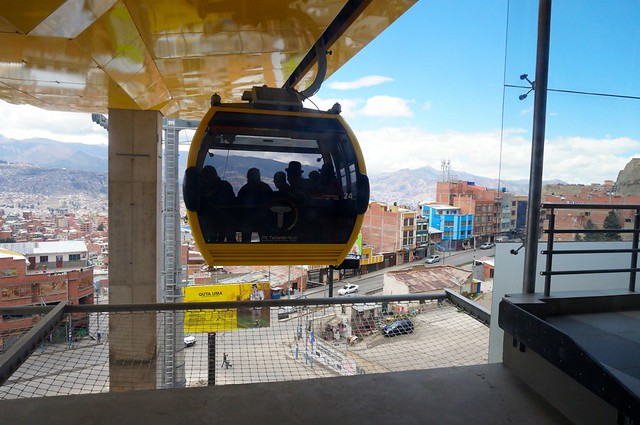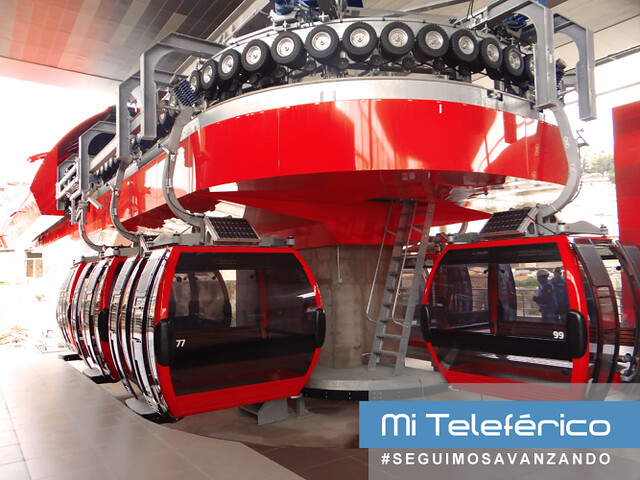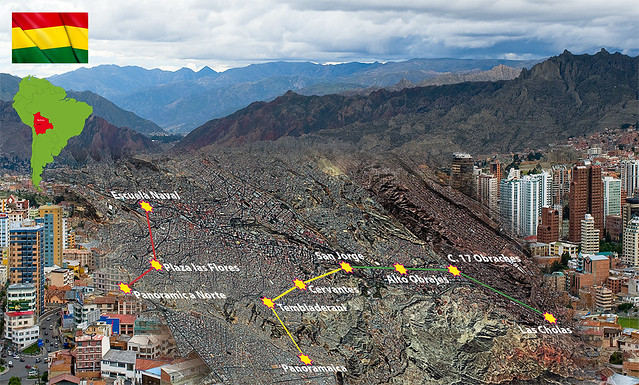The earliest known use of cable transit for passenger transportation was in 250 B.C in South China. Though they have been used in European ski resorts for decades, it is only in the last few years that their use in urban centres has become widespread.
Last year (2014), the Bolivian Government launched what is now the longest network of urban cable cars stretching a distance of almost 10 km.
The network consists of three lines, a Red line (opened on 30 May 2014), a Yellow line (Opened on 15 September 2014) and Green Line (opened on 4 December 2014). The three colours represent the colours of the Bolivian flag. In total the system has 11 stations and is held together by 74 towers.
| Line (colour) | Connecting Points | Distance | Time taken | Number of stations | Number of cars |
| Yellow | Mirador/Qhana Pata – Chuqui Apu/Libertador | 3.9 km (2.4 mi) |
13.5 min | 4 | 169 |
| Red | 16 de Julio/Jach’a Qhathu – Estación Central/Taypi Uta | 2.4 km (1.5 mi) |
10 min | 3 | |
| Green | Chuqui Apu/Libertador – Irpawi/Irpavi | 3.7 km (2.3 mi) |
16.6 min | 4 | |
| 11 stations |
Summary of the Characteristics of the La Paz Cable Car System
La Paz and El Alto are two cities that lie near each other, separated by mountainous terrain. Lying at an altitude of 3,650 metres above sea level (1300 ft), La Paz is the highest capital city in the world. El Alto, a neighbouring city, lies on a plateau that is slightly higher than La Paz. At 4,150 meters (13,615 ft) above sea level, El Alto is the highest city in the world. El Alto was once a suburb of La Paz, but has slowly grown to be bigger than the capital. Officials estimate that 85-90% of the population in the two cities relies on public transport.
The topography of La Paz makes the construction of urban trains and highways economically and commercially unrealistic. Prior to the construction of the cable car, the residents relied on private vans using narrow and winding streets amid traffic congestion. Not only were these unpredictable, noisy and unreliable, they were also generally time consuming. Since the opening of the Mi Teleferico (My Cable Car), as it is called, there have been reports of trips taking up to half of the original time, saving anywhere from 30 minutes to one hour. Additionally, the service is reliable, fast and comfortable. Compared to other means of public transportation, Mi Teleferico is viewed as a cleaner travel mode in terms of the environment due to low carbon emissions and as peaceful in contrast with the daily experience of blaring horns and shouting of public transportation. Other attractive features include half fare for students, elderly passengers and those with disabilities, as well as free internet at the stations.
Tickets cost three Bolivianos an equivalent of .40 cents USD or £0.25, which, though slightly more than the minibus fare, stillfalls within an affordable range. Within the first who months, the Red Line transported 2.3 million passengers, collecting over 8 million Bolivianos (USD$ 1.2 million) in fares, beating initial estimates. Initial estimates had predicted 35,000 users daily, but the actual average ridership is approximately 42,000.
Mi Teleferico did not come easily. Initial proposals made in the early 90’s were shelved due to lack of political support, especially fear of the impact it would have on those employed by the existing transport sector. This time, however, it had political backing from the top, under the leadership of President Evo Morales. Research and budgeting were followed by the selection of an Austrian firm Doppelmayr Garaventa Group, to carry out the project. Doppelmayr are the world’s leading Cable Car company. The Project employed over 1,200 Bolivians and local professionals are now undergoing training on how to operate the system.
The entire 243 million USD project was financed by Bolivia, with funds from hydrocarbons revenues (taxes and royalties) accruing to the government plus a loan from the Bolivian Central Bank. Though some experts remain skeptical, it is estimated that the capital cost will be amortized in 25 years through a combination of passenger revenues (75%) and commercial income (25%). Commercial income covers retail space and billboards at stations. Morales intends to have profits from the Teleferico used to subsidize the government cash transfer programs.
The spectacular daily view of the city of La Paz with the background of the Andes snow-capped cordillera mountains through the tinted windows of the cable cars is also seen as a potential tourist opportunity that the cable may have created.
Challenges with the system include a few delays, and a case of a tree falling on an empty yellow cabin that resulted in a 3 hour delay and minor injuries to suspended passengers.
The Bolivian government does not intend to stop here; rather it plans to open 6 new lines in Phase Two of the Project: Blue, Orange, White, Purple, Sky Blue, Brown which will add a new 20.3 kms of cable cars. The colours chosen this time are those of the Wiphala flag, which represents the native peoples of South America. This next phase is estimated to cost 450 million USD, far more than the $234 million that was spent on the first three lines.
Cable Cars are now seen as ‘Hot Tickets’ as regards urban transportation. With their high capacities, low cost of construction and environmental friendliness, several cities including London; Portland, Oregon; Medellin, Colombia; Caracas and Rio de Janeiro are all putting them up. The latest announcements of cable car construction are from the Kenyan cities of Nairobi and Mombasa as well as the French cities of Toulouse and Brest.
“Depending on how you measure it,” says Steven Dale of the Gondola Project, “it is the fastest growing transportation method in the world.”
What do you think of the recent development of Cable Transit? Does your City have the potential to use Cable Cars a means of mass urban transit?
Images from Gondola Project, gwenkash.tumblr.com, fastcoexist.com and Doppelmayr Group.




I never knew this. Thanks for sharing.